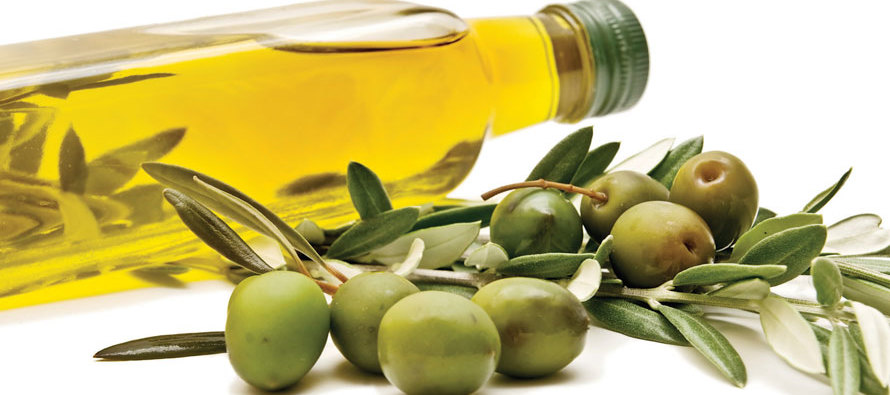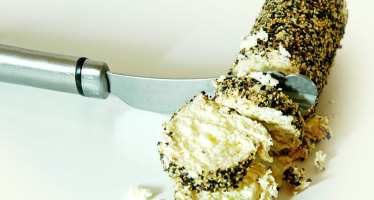O Flavor, Where Art Thou?

Our flavor seeking odyssey begins with The Odyssey, as we find our freshly bathed hero, Odysseus, rubbing himself with olive oil before approaching a beautiful princess. But the ancient world had been using olive oil for lots of wonderful things since before Homer wrote down his adventurous tale of bathing in the 8th Century BC. To get olive oil you need a Mediterranean climate, olive trees and something to crush the olives along with their pits. You’d strain the pulp through fine linen; let the liquid sit to separate the oil (on the bottom) from the water and bitter juices (on top,) then drain the oil from a bottom spout, and the rest from an upper one.
All over “the Med” folks did this, and shipped the stuff to northerly climes via ships in the pottery equivalent of canning jars. The trade networks of Greece and Turkey soon became (like most everything) Roman, and by the time that empire fell, southern Europe, Adriatic States, and North Africa and the Near East all produced their own oils and their own marketing. Enter California, and then the American Southwest, and South and Central America, each producing oils with different and distinct characteristics.
Sour Grapes
If olive oil is olive minus juice and pulp, what is vinegar, then? Since the earliest record of wine dates to around 7000 BC, it would be no great leap of faith in human ingenuity and hunger to put more bacteria into the same hands that made the wine in the first place. You see, vin aigre, or sour wine, as its Latin-based name suggests, is an acidic solution, got in a further chemical reaction after the sugar-eating bacteria had turned grape water into wine, some alcohol-slurping bacteria turn the alcohol into acetic acid.
One might argue that this is not the greatest trade-off; why throw good wine after bad? Even Bronze Age Brewers knew the marvels of vinegar because it tastes good, but it also restores a feng shui-like balance to dishes. Many cuisines of the Southern Hemisphere use citrus for that much-needed acidic sproing to the palate, but if you weren’t in those latitudes, or didn’t have tamarind or annatto, or yuzu (all sour additions to Eastern diets) then you might want to make some vinegar. The highly acidic product was also resistant to bacterial growth, and was ideal for preserving food without dehydrating it the way packing it in salt does. And if you had no salt, you would ferment the living daylights of all your leftover wine, thus saving your food from rotting and your land-bound relatives from the temptation of drinking too much.
Love Makes the World Go Round
But much more than wine or vinegar was consummated from these bacterial bacchanalia. Ah fermentation love, in the Biblical sense: grape juice begets wine or grappa, crushed grain begets bread or beer, milk begets cheese or yogurt, rice gruel begets sake or rice vinegar, cane or palm juice begets cane or palm wine or liquor, raisins beget khall inab or raisin vinegar, corn mash begets bourbon, apple cider begets hard cider or cider vinegar, cabbage begets kim chee, and potatoes beget vodka. But while love can be inevitable, fermentation needs very distinct types of environments and species of bacteria to turn out well. Anyone who has ever bought a wine-making kit for $29.99 can tell you that. And while fermentation was known to many, it was only when Louis Pasteur magnified the little squiggly things responsible for the magic that it was really understood by science.
Yo’ Mama
So what to do if you were a Nebraska rancher in the 1800’s and you wanted vinegar? You might hop a ship to Modena in Italy and spend your fortune on some aged balsamic, but most likely you’d go and ask your neighbor’s mother. Sorry, scratch that. You’d ask your neighbor for his mother. And no, he would not level a shotgun at you and tell you to “git.” He would go and fetch a crock with a wobbly, slimy, half-live brownish thing, and scoop some of it into your crock which you would have had the foresight to bring.
You would carry this unspeakable-looking thing tenderly home, and pour into it some of whatever fruit-derived alcoholic stuff you have, perhaps Aunt Frieda’s gooseberry wine that had been sitting on the shelf for donkey’s ages. You would cover the crock, store it in a cool dark place and wait for it to make vinegar while you ranched up the doggies. Your mother now, is a mother of vinegar, very similar to the sourdough starter containing yeast that you might also have borrowed from your Great Plains neighbor, at least until he started getting the shotgun out anyway because you didn’t loan him anything back.
Alternative Medicines
History tells us that vinegar has been used for things such as treating sprains (soak a towel in it and swathe affected area,) rinsing fruit and veg to limit mold growth, mixing with plaster of Paris to delay hardening for home wall repair, soaking lamp wicks to keep them from smoking, and as an antidote for ammonia poisoning. Vinegar can pickle anything you can fit into a jar (see my last article or reference the mid-19th century White House Cook Book,) and Elizabeth David, 1950’s British Hall of Fame Cookery Superstar said vinegars are indispensable for rich dishes, particularly for her “Sour Red Cabbage and Sausage.” According to some, vinegar is a wonder-medicine, and just looking at it will help you drop the pounds. This may be exaggeration, but it does bring a lot of flavor without bringing a lot of calories or salt as well.
The more recent history of olive oil includes its use as a laxative, holy anointing oil, a digestive, lamp oil, sunburn treatment, skin softener, wood conditioner, preservative, and antiseptic. More and more, olive oil has rewarded eager diners with ice cream, popcorn dressing, cakes and scones, and oil-poached seafood or fowl. Artisan prices are being paid for EVOO (as some chefs abbreviate extra virgin olive oil,) but as a recent exposé in the New Yorker pointed out, buyers must beware and make sure they are getting the real thing, since it is one of the foods most often diluted with sub-standard product and sold at premium prices.
Health claims also abound. It’s an unsaturated oil that is unprocessed with heat or hydrated to form trans fatty acids; it is loaded with polyphenols and is about the best oil you can ingest. But there are way better reasons for using it. Try making up a classic vinaigrette with real olive oil: A dab of Dijon mustard, dash of salt, a tablespoon of lemon juice or good vinegar and a quarter cup or so of olive oil. Whisk. Couldn’t be easier. Get crazy and add herbs, honey, anchovy, or minced garlic. Then do the same thing with some clear oil your aunt might have used. If you can stand to taste the latter, you’ll put your money on, and finish the former. How to be sure you get the good stuff? Check your sources.
Chef2 (Chef Squared) Brings the Odyssey of Flavor to Omaha
Ancient history becomes new artisan in an Omaha original olive oil and vinegar store. Chef2 will sell tasty small batch oils and vinegars, infused, flavored and specialty oils and vinegars, delectable gift baskets, and an array of health and beauty items featuring these ingredients. To help one navigate the culinary and dietary waters, Chef2 will hold tastings as well as classes on everything from learning professional cooking methods to molecular gastronomy to cocktail chemistry. At the helm of this flavor adventure, coming soon to midtown crossing, are Jim Trebbien, his son Ben, wife Patty, and head chef Mike Combs. Mr. Trebbien and Mr. Combs form a phalanx of gastronomic influence from The Institute for the Culinary Arts at Metro Community College; son Ben is a business management specialist, and Patty is a registered dietician.
Jim Trebbien believes that through a common desire to achieve excellence and innovation, new restaurants in Omaha, especially those in the community of Midtown Crossing, are coming into a culinary Golden Age, wherein suppliers like Chef2 can enrich and enlighten diners and home cooks, while working with top local chefs and kitchens. “We have a very vibrant food community here,” says Jim, “and we’re excited to be a part of it.”
But after all, an odyssey is all about seeking out new lands and new ideas. Take for example manager Ben Trebbien’s favorite olive oil: “It’s infused with blood oranges, and it would be just perfect for brownies.” The frontier of modern, healthy desserts has, it seems, gotten yummier.
But check out Patty Trebbien. As a registered dietician, she is excited about the health benefits of the olive oils and their potential for use in those desserts (as a replacement for high-fat butter, and even worse trans-fat oils and shortenings) but she’s also looking forward to introducing folks to the tastiest salt-substitutes ever: balsamic vinegars. Her favorite, a white champagne balsamic has a mild flavor, gentle acidity and an unaccountable salty finish.
Setting a course to ensure quality, host tastings, and teach classes will be Chef Mike Combs, who knows his olive oil and vinegars like Odysseus knew how to row a boat and motivate a crew. He loves the Spanish olive oils for their robust flavor and body, and along with luscious Spanish oils, his fleet will consist of Italian, Chilean, Greek, and California extra virgin olive oils. The vinegars will come from the some of the same regions, particularly the region of Emilia Romagnia, Italy, where Modena — the beating heart of Italian balsamics — is located. He will also include some red wine vinegars, prosecco (a sparkling Italian wine) vinegar, and some from celebrated local producers such as George Paul. Chef Mike says Chef2 will ensure good storage conditions, freshness, and a familiarity with the oils and vinegars, even bottling the product on site in front of the customer. This emphasis on preserving flavor takes knowing your source to a whole new level.
The Voyage Home
Just as it took Odysseus a while (what’s ten years, anyway?) to get home to his faithful wife and son, it took a while for flavor and healthfulness to take precedence in our diets. We still care about how food looks, and how satisfying it is, but we also care about how it tastes, where it comes from, and whether it is good for us. Increasingly, we look to time-tested and even ancient foodstuffs to grace our table, hoping that in the end, we come back to our own hearths with new traditions of tastiness, based on well-tried and well-traveled ingredients.

Ann Summers
Ann Summers is not a 40-umpthing-year old rock climber who got shut down in Boulder Canyon and drowned her failure in a microbrewery. She is neither a mother of two, a fan of Latin plant names nor a lover of fine Italian Grappa. You’ll not catch her shooting guns for fun or hollering like a redneck. She hates Shakespeare, and doesn’t call a certain fast food chain “The Scottish Restaurant.” She turns her nose up at organic yellow beets, eschews fresh oysters, and loathes chubby guinea pigs with Violent Femmes hairdos. She is also a dreadful liar
Related Articles
Finding Your Favorite Cheese
Of all the jobs that I’ve had in my illustrious career as a global food citizen, there were none that
Bayou Bonanza: An exploration of Omaha’s expanding Cajun, creole, and soul food scene.
It was a warm and windy Wednesday morning in Mid-June. My girlfriend Melissa and I were driving down Interstate 77
Nebraska Journalist-Author Genoways Takes Micro and Macro Look at the U.S. Food System
It should come as no surprise that a writer, who chronicled a year in the life of a Nebraska farm
No comments
Write a commentOnly registered users can comment.














